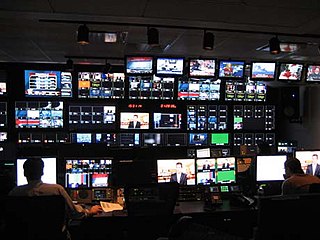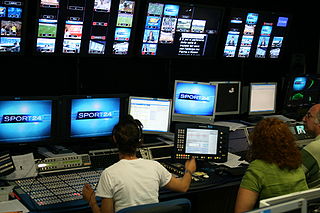A technical director (TD) is usually a senior technical person within e.g. a software company, engineering firm, film studio, theatre company or television studio. This person usually has the highest level of skill within a specific technical field.

Pebble Mill Studios was the BBC's television studio complex located in Edgbaston, Birmingham, England, United Kingdom, which served as the headquarters for BBC Birmingham from 1971 until 2004. The nine-acre site was opened by Princess Anne on 10 June 1971, and in addition to the studios contained two canteens, a post office, gardens, a seven-storey office block, and an outside broadcasting (OB) base.
Broadcast automation incorporates the use of broadcast programming technology to automate broadcasting operations. Used either at a broadcast network, radio station or a television station, it can run a facility in the absence of a human operator. They can also run in a live assist mode when there are on-air personnel present at the master control, television studio or control room.

Master control is the technical hub of a broadcast operation common among most over-the-air television stations and television networks. It is distinct from a production control room (PCR) in television studios where the activities such as switching from camera to camera are coordinated. A transmission control room (TCR) is usually smaller in size and is a scaled down version of centralcasting.

A vision mixer is a device used to select between several different live video sources and, in some cases, compositing live video sources together to create visual effects.

A television studio, also called a television production studio, is an installation room in which video productions take place, either for the production of live television and its recording onto video tape or other media such as SSDs, or for the acquisition of raw footage for post-production. The design of a studio is similar to, and derived from, movie studios, with a few amendments for the special requirements of television production. A professional television studio generally has several rooms, which are kept separate for noise and practicality reasons. These rooms are connected via 'talkback' or an intercom, and personnel will be divided among these workplaces.

The production control room (PCR) or studio control room (SCR) is the place in a television studio in which the composition of the outgoing program takes place.

A character generator, often abbreviated as CG, is a device or software that produces static or animated text for keying into a video stream. Modern character generators are computer-based, and they can generate graphics as well as text.
Television crew positions are derived from those of film crew, but with several differences.
The Technology and Engineering Emmy Awards, or Technology and Engineering Emmys, are one of two sets of Emmy Awards that are presented for outstanding achievement in engineering development in the television industry. The Technology and Engineering Emmy Awards are presented by the National Academy of Television Arts and Sciences (NATAS), while the separate Primetime Engineering Emmy Awards are given by its sister organization the Academy of Television Arts & Sciences (ATAS).
A television station is a set of equipment managed by a business, organisation or other entity such as an amateur television (ATV) operator, that transmits video content and audio content via radio waves directly from a transmitter on the earth's surface to any number of tuned receivers simultaneously.

CITV is a British children's morning programming block on ITV2 and formerly a free-to-air channel owned by ITV plc. CITV, then Children's ITV, launched on 3 January 1983 as a late afternoon programming block on the ITV network for children aged 6–12. It replaced the earlier Watch It! branding and introduced networked in-vision continuity links between programmes. These links were originally pre-recorded from a small London studio up until 1987, when Central won the contract to produce live links from their Birmingham studios. In 2004, presentation of CITV was relocated to Granada Television in Manchester, which saw the demise of in-vision continuity. Nine years later, the operations moved to ITV Granada's MediaCityUK studios in Salford.

Disney Channel was a British and Irish children's pay television channel owned and operated by The Walt Disney Company (UK) Ltd, an overseas subsidiary of The Walt Disney Company. Active from 1995 to 2020, the channel catered to the entertainment needs of young audiences in the region. This British and Irish iteration is distinct from the original namesake American channel of the same name, which remains operational.
In broadcasting, channel playout is the generation of the source signal of a radio or television channel produced by a broadcaster, coupled with the transmission of this signal for primary distribution or direct-to-audience distribution via any network. Such radio or television distribution networks include terrestrial broadcasting, cable networks, satellites, IPTV, OTT Video, point-to-point transport over managed networks or the public Internet, etc.
TeleMation Inc. was a company specializing in products for the television industry, post-production and film industry, located in Salt Lake City, Utah. TeleMation started with a line of black-and-white video equipment, and later manufactured color video products. Lyle Keys was the founder and president of TeleMation, Inc., started in the late 1960s. Early equipment was for the B&W broadcast, cable television, and CCTV market.

In broadcast facilities and television studios, a central apparatus room, central machine room, or central equipment room (CER), or central technical area (CTA), or rack room is where shared equipment common to all technical areas is located. Some broadcast facilities have several of these rooms. It should be air-conditioned, however low-noise specifications such as acoustical treatments are optional. Equipment is connected either directly with an attached foldout monitor, keyboard and mouse or remotely via KVM switch, SSH, VNC, RS-232 or remote desktop.
A Presentation Director is a person who works in the broadcast television industry. They are responsible for the playout of all television programmes, commercials and other material.
In terrestrial radio and television broadcasting, centralcasting refers to the use of systems automation by which customised signals for broadcast by multiple individual stations may be created at one central facility.

SES Platform Services GmbH was a subsidiary company of SES based in Betzdorf, Luxembourg. From its headquarters in Unterföhring near Munich, Germany, SES Platform Services operated a broadcasting centre, providing a wide range of services, including content management, playout, encryption, multiplexing, satellite uplinks and other digital TV media broadcast services for the broadcast industry.
Channel in a box is the name given to an all-in-one playout device for broadcast television. Commonly based on a standard PC, it includes the ability to store content immediately required, add graphics, and deliver it to a transmission chain. Thus it provides an integrated, software playout platform.










